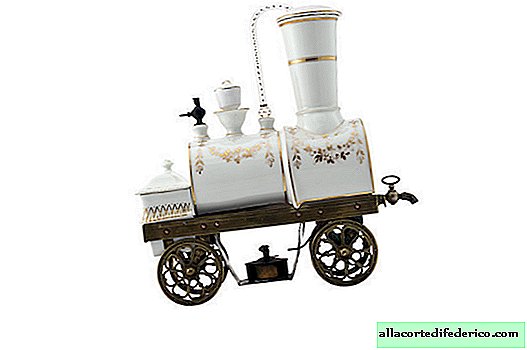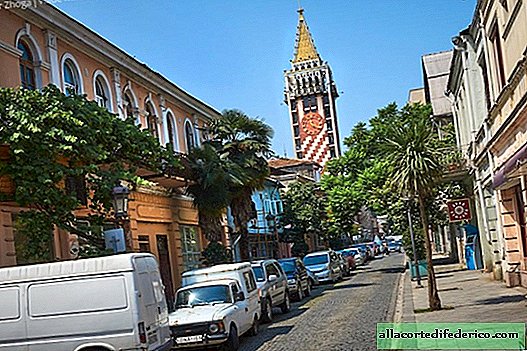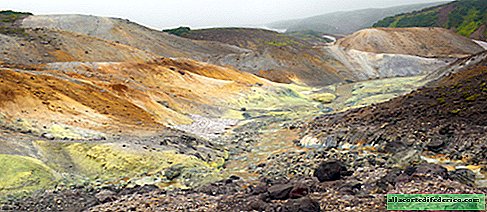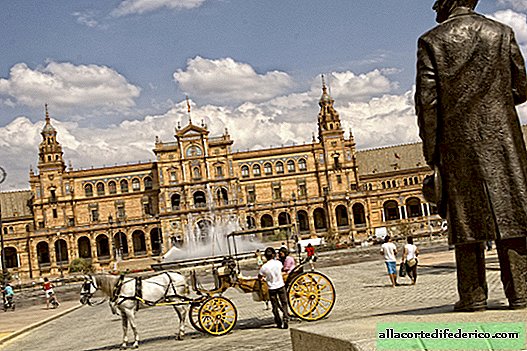Steam engine or coffee maker: the most advanced coffee making machine of the 19th century
Only very wealthy people could afford such an elegant thing.
At the turn of the 18th and 19th centuries a steam locomotive appeared. English engineer Richard Trevitik launched the first steam engine for a coal company. This step opened wide gates to the future and reduced distances. At first, steam locomotives called land steamers. When people realized that long trips in time were reduced from weeks to several hours - this entailed a cultural upheaval in consciousness. The so-called "railway fever" began. Businessmen and designers connected to it.
One of them, the Franco-Italian inventor, J. B. Toselli, invented a magnificent steam locomotive-coffee maker.
 There was room for matches and sugar on the back of each coffee maker. So the designer took care of usability
There was room for matches and sugar on the back of each coffee maker. So the designer took care of usabilityThe Toselli coffee machine-locomotive has the form of a train with all the necessary attributes - a pipe from which steam exits, an engine, wheels. Interestingly, the wheels do spin. This engine is the only engine in the world that is made of blue or pink ceramic, decorated with flower medallions and fluttering butterflies.
The coffee world in the mid-19th century, like the whole of British industry, was experiencing a technological boom. The Loysel coffee machine could produce 2,000 cups of coffee per hour. Prior to this, in 1800, the French archbishop de Bellois created a drip coffee maker, in which boiling water once passed through a special filter where ground coffee was poured. In 1840, Robert Napier, inventor from Scotland, proposed the first vacuum coffee maker. In it, hot water passed through the coffee filler and returned to the initial water tank due to the vacuum formed.
But even against the backdrop of such inventions, the Toselli coffee train looks like something special! Enrico Maltoni, a collector, coffee expert and author of books on the history of coffee, noted that the ritual of preparing the drink has turned into a real theater. If earlier it was done by cooks in the kitchen, now coffee was brewed in the living rooms. Before Toselli, there were coffee machines in the form of trains made of silver and brass, but only he managed to turn them into works of art. Toselli made them more glamorous, ennobled with elegant decor.
 Toselli steam locomotive
Toselli steam locomotiveUnder the influence of these processes, the engine starts to move, thereby setting in motion a special cover that extinguishes the alcohol burner. This creates a vacuum effect. The coffee is pulled back through the filter, the grounds remain. After that, the drink is ready to drink. It is poured through a pipe going under the train.
The steam locomotive-coffee maker not only brewed coffee, but also whistled like a real train, and moved, which enthralled the audience.
 Each product had its own characteristics. Colors never repeated
Each product had its own characteristics. Colors never repeatedThe safety valve added by Toselli in the form of a small tap at the top made the coffee machine safe. It was an innovation for that time. Steam locomotives and vacuum coffee makers in the 19th century were notorious - they exploded under steam pressure. Train wrecks caused numerous casualties. The first railway accident happened in 1815. There was a demonstration of the "Mechanical Traveler" steam locomotive, created by the English engineer William Brunton. An explosion occurred because the boiler could not withstand the vapor pressure and burst into fragments, which mortally wounded 16 spectators, many of the injured were taken to neighboring hospitals. Exploding coffee makers, of course, were not so dangerous, but could cripple people. Jan Bursten, a coffee expert, called them "table pomegranates."
This magic coffee making toy has never been mass produced. Only rich people could afford it. Coffee trains were produced in limited quantities. Enrico Maltoni is today the most famous collector. He shows part of his collection at exhibitions and the museum of coffee machines. For many collectors, the Toselli coffee locomotives are a "vague object of desire."
Today, Toselli products cost more than 10,000 euros. But is this money for true coffee lovers?

















